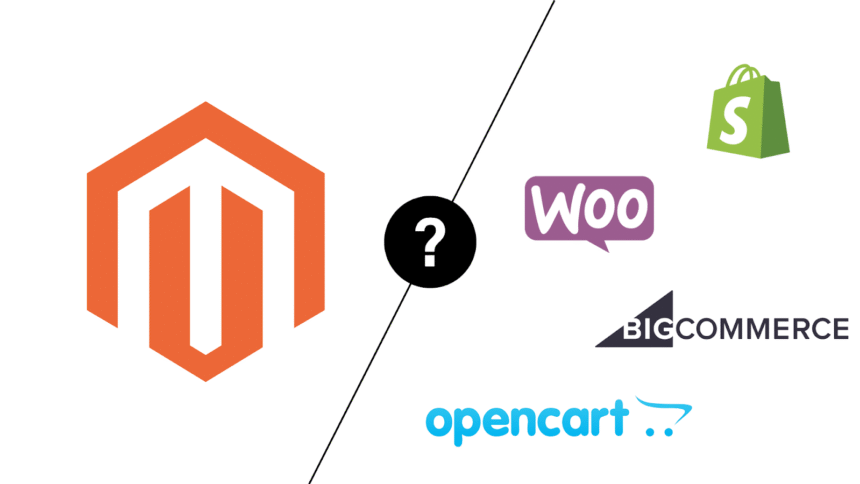In the ever-evolving world of ecommerce, choosing the right platform for your online store is crucial. With numerous options available, it can be challenging to determine which one best suits your business needs. Magento 2, known for its flexibility and scalability, is often customized to meet specific requirements through Magento development services. We will compare Magento 2 with other popular ecommerce platforms, helping you make an informed decision for your online business.
Overview of Magento 2
Magento 2 is an open-source ecommerce platform known for its flexibility, scalability, and robust feature set. Released in 2015 as a significant upgrade to its predecessor, Magento 2 offers improved performance, enhanced security, and a more user-friendly admin interface. It’s particularly popular among medium to large-sized businesses and those with complex product catalogs or unique customization requirements.
Key features of Magento 2 include:
- Flexible architecture for customization
- Powerful SEO tools
- Multi-store and multi-language support
- Advanced marketing and promotional tools
- Robust security features
- Mobile-responsive design
Magento 2 comes in two editions: Magento Open Source (formerly Community Edition) and Magento Commerce (formerly Enterprise Edition). The Open Source version is free to download and use, while the Commerce edition offers additional features and support for a fee.
Magento vs. Shopify
Shopify is one of the most popular ecommerce platforms, known for its ease of use and quick setup. Let’s compare Magento 2 and Shopify across various aspects:
Ease of Use
- Shopify: Known for its user-friendly interface and simple setup process. It’s ideal for beginners and small businesses.
- Magento 2: Has a steeper learning curve but offers more control and customization options. It’s better suited for businesses with technical expertise or resources.
Customization
- Shopify: Offers a range of themes and apps but has limitations on deep customizations.
- Magento 2: Provides extensive customization capabilities, allowing for unique store designs and functionalities.
Scalability
- Shopify: Good for small to medium-sized businesses but can become limiting for larger enterprises.
- Magento 2: Highly scalable, capable of handling large product catalogs and high traffic volumes.
Pricing
- Shopify: Offers tiered pricing plans, starting from $29/month for basic features.
- Magento 2: Open Source version is free, but costs can add up with hosting, development, and extensions.
SEO Capabilities
- Shopify: Provides basic SEO features out of the box.
- Magento 2: Offers more advanced SEO tools and greater control over SEO elements.
While Shopify is often the go-to choice for small businesses and startups due to its simplicity, Magento 2 is preferred by larger businesses or those requiring extensive customization and scalability. The choice between Magento vs Shopify is dependent mainly on the size of business.
Magento 2 vs. WooCommerce
WooCommerce is a popular ecommerce plugin for WordPress, known for its simplicity and integration with the world’s most used content management system. Here’s how it compares to Magento 2:
Platform Base
- WooCommerce: A plugin for WordPress, benefiting from WordPress’s ease of use and extensive ecosystem.
- Magento 2: A standalone ecommerce platform built from the ground up for online retail.
Ease of Use
- WooCommerce: Relatively easy to set up and use, especially for those familiar with WordPress.
- Magento 2: More complex, requiring more technical knowledge or professional assistance.
Customization
- WooCommerce: Offers a wide range of themes and plugins, with customization possible through WordPress.
- Magento 2: Provides deeper customization options but may require more development expertise.
Scalability
- WooCommerce: Suitable for small to medium-sized stores but may struggle with very large catalogs or high traffic.
- Magento 2: Highly scalable, capable of handling enterprise-level ecommerce needs.
Cost
- WooCommerce: The plugin is free, but costs can add up with premium themes, plugins, and hosting.
- Magento 2: Open Source version is free, but total cost of ownership can be higher due to development and hosting needs.
WooCommerce is often the choice for small businesses or those already using WordPress, while Magento 2 is preferred for larger, more complex ecommerce operations.
Magento 2 vs. BigCommerce
BigCommerce is a SaaS (Software as a Service) ecommerce platform that has gained popularity for its robust features and ease of use. Let’s see how it stacks up against Magento 2:
Hosting
- BigCommerce: Fully hosted solution, reducing technical overhead for merchants.
- Magento 2: Self-hosted (Open Source) or cloud-hosted (Commerce), offering more control but requiring more management.
Ease of Use
- BigCommerce: User-friendly interface with a shorter learning curve.
- Magento 2: More complex, requiring more technical knowledge or professional help.
Customization
- BigCommerce: Offers good customization options but not as extensive as Magento 2.
- Magento 2: Provides deep customization capabilities, allowing for unique store experiences.
Scalability
- BigCommerce: Good scalability, suitable for growing businesses.
- Magento 2: Highly scalable, ideal for large enterprises and complex business models.
Built-in Features
- BigCommerce: Comes with a wide range of built-in features, reducing the need for additional apps.
- Magento 2: Offers extensive features in the core platform, with the ability to extend functionality through modules.
BigCommerce is often chosen by businesses looking for a balance between ease of use and robust features, while Magento 2 is preferred by those needing extensive customization and scalability.
Magento 2 vs. PrestaShop
PrestaShop is another open-source ecommerce platform that’s popular, especially in Europe. Here’s how it compares to Magento 2:
Community and Market Share
- PrestaShop: Strong presence in Europe, with a growing global community.
- Magento 2: Larger global market share and community, especially in North America and Asia.
Ease of Use
- PrestaShop: Generally considered easier to use and set up than Magento 2.
- Magento 2: More complex, with a steeper learning curve.
Customization
- PrestaShop: Offers good customization options through modules and themes.
- Magento 2: Provides more extensive customization capabilities, allowing for unique implementations.
Performance
- PrestaShop: Good performance for small to medium-sized stores.
- Magento 2: Better performance for large catalogs and high traffic volumes, especially with proper optimization.
Cost
- PrestaShop: Free to download, with costs for hosting, themes, and modules.
- Magento 2: Open Source version is free, but total cost of ownership can be higher due to development and hosting needs.
PrestaShop is often chosen by small to medium-sized businesses, particularly in Europe, while Magento 2 is preferred by larger businesses or those requiring extensive customization globally.
Key Factors to Consider When Choosing an ecommerce Platform
When deciding on the best ecommerce platform for your business, consider the following factors:
- Business Size and Growth Potential: Choose a platform that can accommodate your current needs and future growth.
- Budget: Consider not just the initial costs but also ongoing expenses for hosting, maintenance, and upgrades.
- Technical Expertise: Assess your team’s technical capabilities and whether you’ll need to hire developers or agencies.
- Customization Needs: Determine how much customization your store requires in terms of design and functionality.
- Scalability: Ensure the platform can handle increased products, orders, and traffic as your business grows.
- SEO and Marketing Tools: Look for built-in SEO features and marketing capabilities to help grow your online presence.
- Payment and Shipping Options: Check if the platform supports the payment gateways and shipping methods you need.
- Security: Ensure the platform offers robust security features to protect your store and customer data.
- Support and Community: Consider the availability of support resources and the strength of the platform’s community.
- Integration Capabilities: Verify that the platform can integrate with other tools and systems your business uses.
Pros and Cons of Magento 2
To help you make an informed decision, let’s summarize the main advantages and disadvantages of Magento 2:
Pros:
- Highly Customizable: Magento 2 offers extensive customization options, allowing for unique store designs and functionalities.
- Scalability: It can handle large product catalogs and high traffic volumes, making it suitable for growing businesses.
- Strong SEO Capabilities: Magento 2 provides advanced SEO tools and features to improve your store’s visibility.
- Multi-store and Multi-language Support: Ideal for businesses operating in multiple regions or languages.
- Large Community and Ecosystem: Access to a wide range of extensions, themes, and developer resources.
- B2B Features: Magento 2 Commerce edition offers robust B2B functionalities.
- Mobile-responsive: Built-in responsive design ensures a good mobile shopping experience.
Cons:
- Steep Learning Curve: Magento 2 can be complex to set up and manage, especially for beginners.
- Higher Costs: While the Open Source version is free, total ownership costs can be high due to development and hosting needs.
- Performance Issues: Without proper optimization, Magento 2 can face performance challenges.
- Resource Intensive: Requires more server resources compared to some other platforms.
- Regular Maintenance: Requires ongoing maintenance and updates to ensure security and performance.
When to Choose Magento 2
Magento 2 might be the best ecommerce platform for your business if you:
- Have a large or complex product catalog.
- Business requires extensive customization in terms of design or functionality.
- Need a scalable solution to accommodate future growth.
- Operate in multiple countries or languages.
- Have the technical resources or budget to manage a more complex platform.
- Require advanced B2B features (with Magento Commerce).
- Want full control over your ecommerce environment.
- Your business model includes unique or complex pricing, promotion, or customer group structures.
However, if you’re a small business with limited technical resources, or if you need a simple, quick-to-launch solution, you might want to consider alternatives like Shopify or WooCommerce.
Conclusion
Choosing the best ecommerce platform for your business is a crucial decision that can significantly impact your online success. While Magento 2 offers powerful features, extensive customization options, and excellent scalability, it may not be the ideal choice for every business.
Whichever platform you choose, focus on creating a user-friendly shopping experience, optimizing for search engines, and providing excellent customer service. These factors, combined with the right ecommerce platform, will set you on the path to online retail success.














